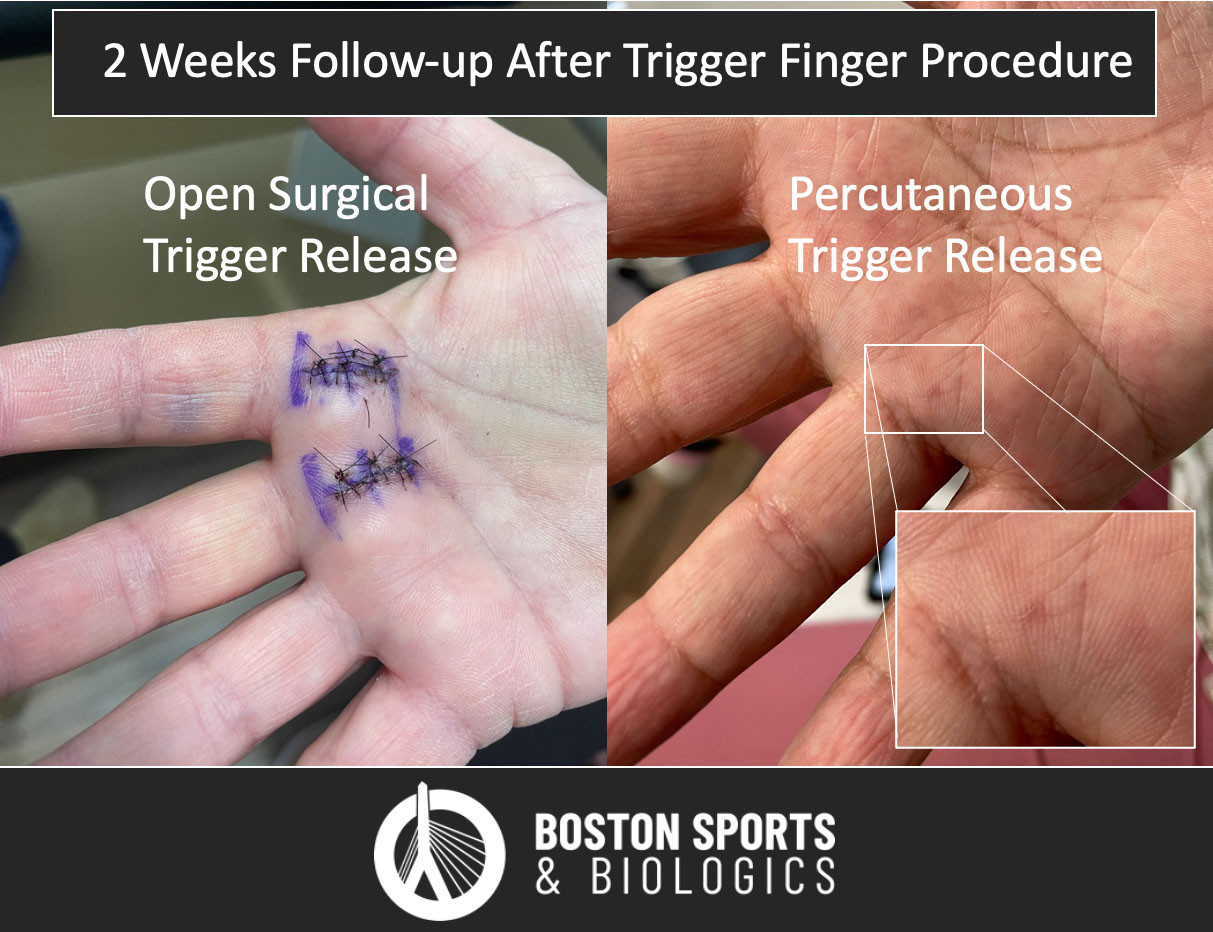
Trigger finger is a condition characterized by clicking or locking of the finger during finger movement. Catching of the tendon can occur due to inflammation or swelling of the tendon or the fibrous bands (“pulleys”) that hold the tendons close to the bone. The most common site of triggering occurs at the A1 pulley.
*Reproduced from JF Sarwak, ed: Essentials of Musculoskeletal Care, ed 4. Rosemont, IL, American Academy of Orthopaedic Surgeons, 2010.
Trigger finger is one of the most common causes of hand pain.
Percutaneous trigger finger release is minimally invasive and offers a quicker recovery.

Abdoli A, Hashemizadeh Aghda SM, Jalil Abrisham SM. Comparing the Corticosteroid Injection and A1 Pulley Percutaneous Release in Treatment of Trigger Finger: A Clinical Trial. J Hand Surg Asian Pac Vol. 2021 Jun;26(2):207-213. Read Article
Colberg RE, Pantuosco J, Fleisig G, Drogosz M. Ultrasound-Guided Microinvasive Trigger Finger Release Technique Combined With Three Tests to Confirm a Complete Release. Am J Phys Med Rehabil. 2020 Dec;99(12):1150-1156. Read Article
Gancarczyk SM, Jang ES, Swart EP, Makhni EC, Kadiyala RK. Percutaneous Trigger Finger Release: A Cost-effectiveness Analysis. J Am Acad Orthop Surg. 2016 Jul;24(7):475-82. Read Article
Guo D, McCool L, Senk A, Tonkin B, Guo J, Lytie RM, Guo D. Minimally invasive thread trigger digit release: a preliminary report on 34 digits of the adult hands. J Hand Surg Eur Vol. 2018 Nov;43(9):942-947. Read Article
Liu WC, Lu CK, Lin YC, Huang PJ, Lin GT, Fu YC. Outcomes of percutaneous trigger finger release with concurrent steroid injection. Kaohsiung J Med Sci. 2016 Dec;32(12):624-629. Read Article
Marij Z, Aurangzeb Q, Rizwan HR, Haroon R, Pervaiz MH. Outpatient Percutaneous Release of Trigger Finger: A Cost Effective and Safe Procedure. Malays Orthop J. 2017 Mar;11(1):52-56. Read Article
Nikolaou VS, Malahias MA, Kaseta MK, Sourlas I, Babis GC. Comparative clinical study of ultrasound-guided A1 pulley release vs open surgical intervention in the treatment of trigger finger. World J Orthop. 2017 Feb 18;8(2):163-169. Read Article
Siddiqui AA, Rajput IM, Adeel M. Outcome of Percutaneous Release for Trigger Digits in Diabetic and Non-diabetic Patients. Cureus. 2019 May 2;11(5):e4585. Read Article
Weiss ND, Richter MB. Percutaneous release of trigger digits. Am J of Orthopedics. 2017; 46(4):E263-E267. Read Article
White RZ, Sampson MJ. Assessment of short-term response and review of technique of ultrasound-guided percutaneous A1 pulley release for the treatment of trigger finger. J Med Imaging Radiat Oncol. 2021 Mar 21. Read Article
Yang TC, Fufa D, Huang HK, Huang YC, Chang MC, Wang JP. Percutaneous A1 Pulley Release Combined with Finger Splint for Trigger Finger with Proximal Interphalangeal Joint Flexion Contracture. J Hand Surg Asian Pac Vol. 2019 Sep;24(3):270-275. Read Article
I have seen Dr. Sussman for a chronic plantar fasciitis. I had seen several physicians regarding this condition and he was the only one who was able to cure it completely. He was understanding, patient and committed to finding a remedy and getting me back to working out and pain free. I couldn't be happier with him as an orthopedic physician.
My experience is simple. I had four tears in my elbow. After Dr. Sussman’s performed PRP on me I was skeptical because it did not work for the first 3 weeks then the fourth week the pain level started to go down. I am now 100 percent better. I pay tennis on an A level and now I can even throw a baseball about 300 yard again.
Dr. Sussman is the first physician I've met during the last eight years of seeking an explanation and successful plan of treatment for my hip and sacroiliac pain. Each visit he has shown both his compassion for what I am going through. I trust Dr. Sussman completely. He takes my perspective as a patient into account, allowing us to work as a team towards a goal.
References:
How is this procedure performed?
What are the risks of a percutaneous release compared to open surgery?
What does the Research Say?